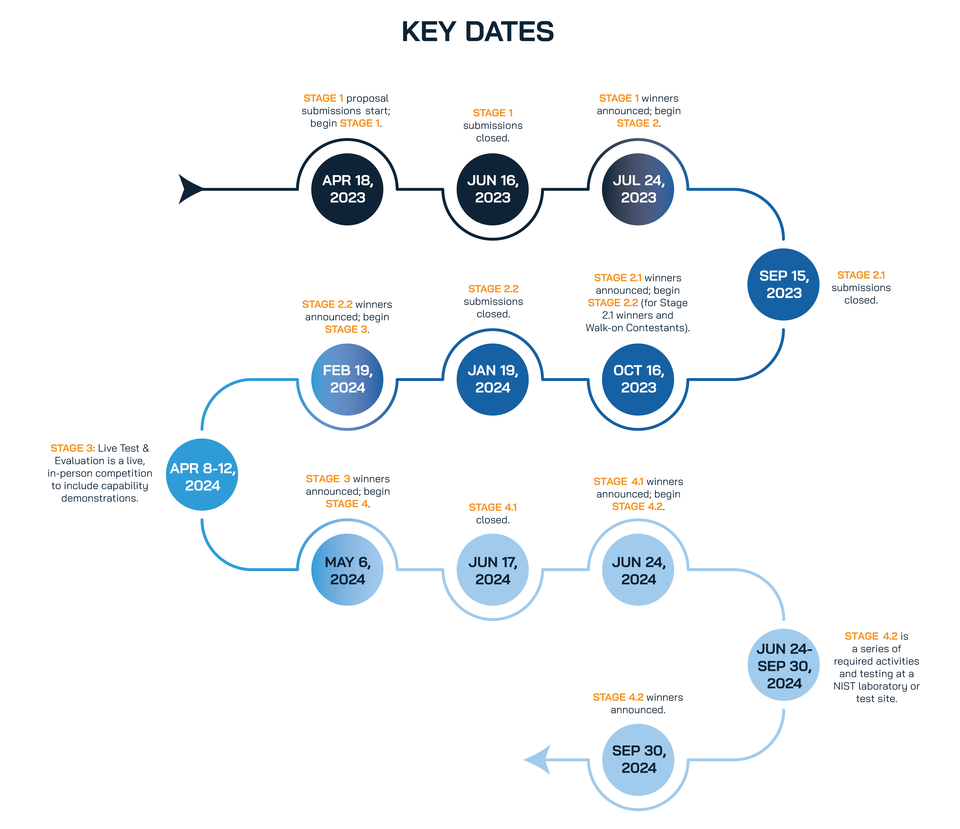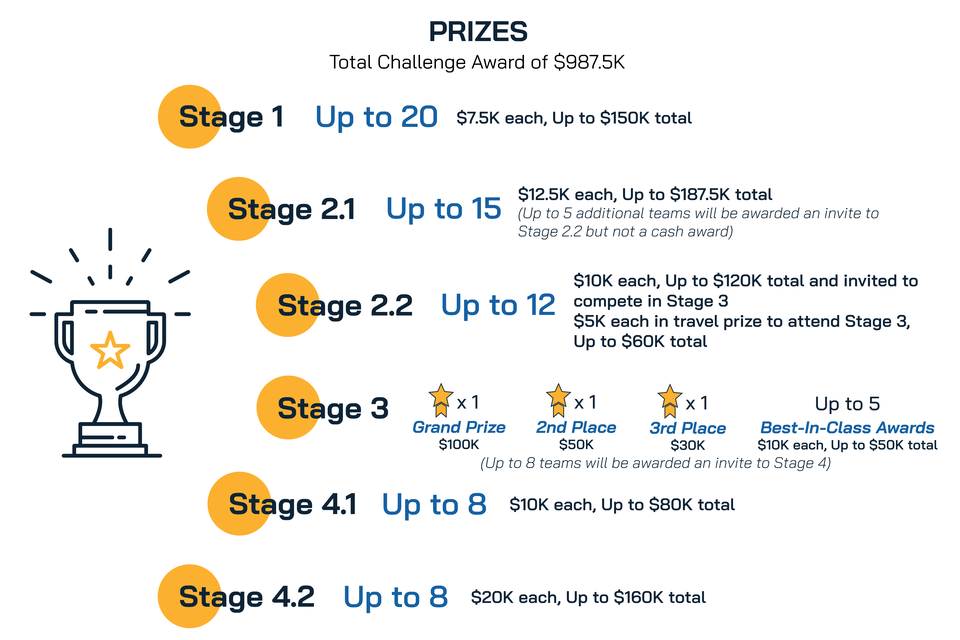2023 First Responder UAS 3D Mapping Challenge
About the First Responder Uncrewed Aircraft System (UAS) 3D Mapping Challenge (UAS 5.0)
Challenge overview
NIST PSCR hosted a four-stage First Responder UAS 3D Mapping Challenge (UAS 5.0) with prize awards of up to $987,500. The goal of this challenge was for contestants to design, build, and operate a cost-effective UAS solution with one or more autonomous or semi-autonomous uncrewed aerial vehicles, and with or without the support of ground robotic vehicles. This challenge built off the First Responder UAS Indoor Challenge (known as UAS 4.0) to provide enhanced situational awareness and image detection for first responders prior to entering a building. Successful solutions provided an accurate, high-quality 3D map in real-time to locate missing person(s) and life-threatening obstacles in an indoor, low-light, GPS-denied, or otherwise constrained environment using a technological mapping method (e.g., simultaneous localization and mapping (SLAM)). UAS prototype solutions aimed to be easy to operate, durable, and provide first responders with a high-quality 3D digital map in real-time to detect human life, obstacles, and hazardous objects in the environment.
Background
There is an urgent need to provide real-time situational awareness to first responders in indoor environments that have been compromised by severe damage due to fire, flood, structural collapse, and other potentially dangerous situations. UAS 4.0 addressed this need by developing a cost-effective uncrewed vehicle that can be used by Incident Command in a constrained environment. However, more could be done to improve UAS as a tool for first responders. Public safety would find a three-dimensional (3D) map of an indoor environment that precisely locates obstacles, damaged structures, people, and other areas or points of interest in real-time or near real-time useful. At the time of UAS 5.0 challenge launch, such a UAS solution was not commercially available at a low cost to support public safety budgets or comply with national security requirements, such as efforts being addressed by Defense Innovation Unit (DIU)’s Blue UAS Cleared List and by the Association for Uncrewed Vehicle Systems International (AUVSI)’s Green UAS Cleared List.
Goals & Objectives
The following were the challenge’s primary objectives:
- Design, build, test, and demonstrate UAS solutions that address the primary need associated with flying a small UAS, or a set of UAS, and optional ground vehicles in an indoor, constrained environment.
- Develop innovative solutions that enhance the first responder’s ability to gain real-time situational awareness of the indoor environment.
- Develop UAS solutions that increase innovation in the UAS commercial market supporting national security as defined in the National Defense Authorization Act (NDAA) for Fiscal Year 2020, including critical components outlined in NDAA Section 848. “Critical components outlined in NDAA Section 848” refers to the flight controller, radio, data transmission device, camera, gimbal, ground control system, operating software, network connectivity, and data storage as included in NDAA Section 848(a)(1)(B)-(D) and further defined at https://www.diu.mil/blue-uas-policy.
The most outstanding Stage 1 solution concepts were eligible to participate in the remaining stages and compete in a live event. Award winners from the live event were eligible to apply and enter a four-month solution accelerator to improve market readiness or further contribute to UAS research.
Please refer to the graphics below for specific key dates and prize amounts.


Challenge winners by stage
Stage 4.2: Solution Accelerator Plan Implementation
The following winners each received $20,000 in prize awards:
- Team AMAV (University of Maryland)
- Team ARCC (Penn State University)
- Team EpiSci
- Team New Horizon Innovations
- Team ResponseWing
- Team Voxel
Stage 4.1: Solution Accelerator Plan Development & Public Safety Partnership
The following winners each received $10,000 in prize awards and an invitation to participate in Stage 4.2: Plan Implementation:
- Team AMAV (University of Maryland)
- Team ARCC (Penn State University)
- Team EpiSci
- Team New Horizon Innovations
- Team ResponseWing
- Team Voxel
Stage 3: Live Test & Evaluation
| Award | Winner | Amount |
|---|---|---|
| 1st Place | ResponseWing | $100,000 |
| 2nd Place | Autonomous Robotics Competition Club (ARCC) | $50,000 |
| 3rd Place | Autonomous Micro Aerial Vehicle (AMAV) | $30,000 |
| Best-in-Class: 3D Map Deliverable | Uniform Sierra <> Purdue UAS | $10,000 |
| Best-in-Class: Map Data Acquisition Speed | Autonomous Micro Aerial Vehicle (AMAV) | $10,000 |
| Best-in-Class: Blue or Green UAS Capable | Autonomous Micro Aerial Vehicle (AMAV) Autonomous Robotics Competition Club (ARCC) | $5,000/team (tie) |
| Best-in-Class: Bill of Materials Total Cost | Autonomous Micro Aerial Vehicle (AMAV) | $10,000 |
| Best-in-Class: First Responders' Choice | Autonomous Robotics Competition Club (ARCC) | $10,000 |
Stage 2.2: Prototype Build & Safety Evaluation
The following winners each received $15,000 in prize awards (including $5,000 for Stage 3 live event travel) and an invitation to participate in Stage 3: Live Test & Evaluation:
- Team Aggie (North Carolina A&T University)
- Team AMAV (University of Maryland)
- Team ARCC (Penn State University)
- Team CTUVA (University of Virginia)
- Team EpiSci
- Team FLYT Aerospace-ManTech
- Team New Horizon Innovations
- Team ResponseWing
- Team Spark Mobility
- Team Uniform Sierra Aerospace / Purdue University
- Team Voxel
Stage 2.1: Design Review
The following winners each received $12,500 in prize awards and an invitation to participate in Stage 2.2: Prototype Build & Safety Evaluation:
- Team AAUNO
- Team Aggie (North Carolina A&T University)
- Team AMAV (University of Maryland)
- Team ARCC (Penn State University)
- Team BlackBee Robotics
- Team CNA Corporation / RIIS LLC
- Team FLYT Aerospace
- Team ManTech
- Team Maroon Scanner (Texas A&M University)
- Team New Horizon Innovations
- Team ResponseWing
- Team ResQVision
- Team Uniform Sierra Aerospace / Purdue University
- Team University of Colorado
- Team Voxel
The following finalists each received an invitation to participate in Stage 2.2: Prototype Build & Safety Evaluation:
- Team CausalTwin
- Team EpiSci
- Team Fire Eye
- Team NYU ARPL
- Team Syndicus Aerospace
Stage 1: Solution Description
The following winners each received $7,500 in prize awards and an invitation to participate in Stage 2.1: Design Review:
- Team AAUNO
- Team Aggie (North Carolina A&T University)
- Team AMAV (University of Maryland)
- Team ARCC (Penn State University)
- Team BlackBee Robotics
- Team CausalTwin
- Team CNA Corporation / RIIS LLC
- Team EpiSci
- Team Fire Eye
- Team FLYT Aerospace
- Team ManTech
- Team Maroon Scanner (Texas A&M University)
- Team New Horizon Innovations
- Team NYU ARPL
- Team ResponseWing
- Team ResQVision
- Team Syndicus Aerospace
- Team Uniform Sierra Aerospace / Purdue University
- Team University of Colorado
- Team Voxel
Additional Information
The First Responder UAS 3D Mapping Challenge was hosted by NIST’s PSCR Division and managed by Capital Consulting Corporation, in partnership with Kansas State University, Salina, KS.

